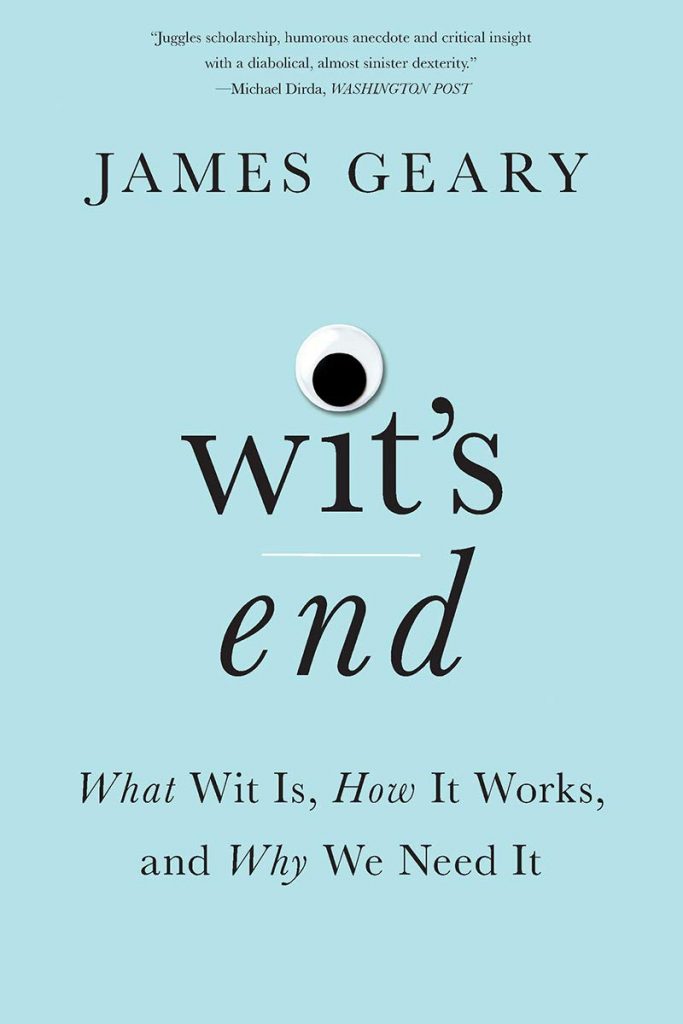
I recently read James Geary’s book, Wit’s End: What Wit Is, How It Works, and Why We Need it.
While it wasn’t the how-to book I was hoping for, I enjoyed it and found lots of ideas to use in the experiences I create.
The book uses an interesting format to approach the topic from different angles. Each chapter is told in a different voice and style.
Here’s a few things I found interesting in the book.
Defining Wit
On his website, Geary defines wit as “The quick, instinctive intelligence that allows us to think, say or do the right thing at the right time in the right place.”
In the book he says that wit is “combining images lying not far apart from one another, yet also not too near, and affecting the hearer with the emotions of surprise and delight”.
Most of the book focuses more on the second definition. It puts more emphasis on the hearer of wit. Wit is, to me at least, is about the effect it has. Making sure it it happens at the right time and place is not the true purpose of wit.
Wit is Deep
Wit and the “Aha” happen when deeper associations are made. It’s not just “words that sound alike”. To make this point, Geary gives us this quote form essayist and humorist Joseph Addison:
“True wit consists in the resemblance of ideas and false wit in the resemblance of words”
To illuminate the point he takes this joke:
“Why can’t you starve in the desert?” Because you can eat the sand which is there.”
And contrasts it with this one from comedian George Carlin:
“Atheism is a non-profit institution.”
In the first example, the (false) wit is “mere lexical coincidence, consisting solely in the resemblance of words.” In the Carlin quote the “non-profit” is a play on “no prophets”. It binds the two ideas in a (true) witty glue. When people say they don’t like puns, I usually assume they only see puns in terms of the former case, completely missing the beauty of the latter. The latter connects ideas and make associations in a fresh way.
Humans Love Connecting Things
It’s well documented that humans have a strong desire to make sense of their world through a cohesive story they tell themselves.
Geary writes of a study of people who viewed “ambiguous artwork” (think Jackson Pollock or some other modern art).
The study determined that those who liked the artwork did not like it because of what it looked like but because it looked ambiguous. “It was the ambiguity itself that viewers found aesthetically pleasing…. The process of working through the ambiguities, not the arrival at any conclusive interpretation, was what stimulated intellectual interest and emotion”.
When I can create something that visitors can “put together” or “figure out for themselves” everyone wins. They get a rush of “aha” or a sense of accomplishment. And if I can make the terrain look random and chaotic to them when they show up, their “aha” is even stronger.
One of the techniques I try to employ is carefully crafting chaos that comes with invisible guardrails. Without them realizing their hands are being held they get an even greater feeling of accomplishment – without doing all the work.
Experience Brainstorming Ideas
I found some great jumping off points for Eureka Room and other IRL XD brainstorming. Here are some of techniques that Geary says were “particulary effective” in ancient argument and storytelling.
Take things literally that are meant figuartively.
Place things commonly understood in one cateogry in an entirely different category.
Benignly violate the most pervasively held expectations.
Deply the ludicrous to get at the astute.
User practical jokes to trip up practical minds.
Equate spiritual wisdom with common sense that meets the existential challenges of everyday life.
Is “Random” Really Random?
Geary points out that “It is necessary that the ideas should not like too near one another in the nature of things; for where the likeness is obvious, it gives no surprise”
There are experiences, movies, musical pieces, etc that can seem to have a lot of “random” things that happen. There seems to be “good” random (“Wow! That so random. hahaha!”). And “bad” random (“I don’t know all that shit was supposed to be. What a mess.”)
No one likes the latter, but many experience seekers seek the former.
I’d argue that “good random” is not really random at all. It’s an experience, likely carefully crafted, filled with associated ideas that are just far enough away to seem random, but they’re actually there for the audience to stitch together into a plausible “story” or “universe”.
“Bad random” is just that – items that are or feel random and do not resolve into any cohesive story in the minds of the visitor.